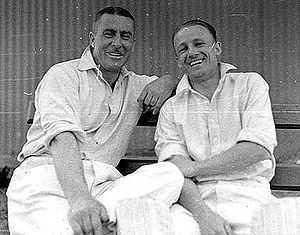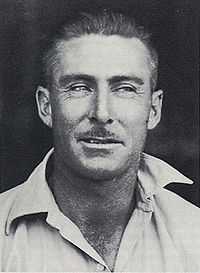Vic Richardson
 | ||||||||||||||||||||||||||||||||||||||||
| Personal information | ||||||||||||||||||||||||||||||||||||||||
|---|---|---|---|---|---|---|---|---|---|---|---|---|---|---|---|---|---|---|---|---|---|---|---|---|---|---|---|---|---|---|---|---|---|---|---|---|---|---|---|---|
| Full name | Victor York Richardson | |||||||||||||||||||||||||||||||||||||||
| Born |
7 September 1894 Parkside, South Australia, Australia | |||||||||||||||||||||||||||||||||||||||
| Died |
30 October 1969 (aged 75) Fullarton, South Australia, Australia | |||||||||||||||||||||||||||||||||||||||
| Nickname | The Guardsman, Yorker | |||||||||||||||||||||||||||||||||||||||
| Height | 1.81 m (5 ft 11 in) | |||||||||||||||||||||||||||||||||||||||
| Batting style | Right-hand | |||||||||||||||||||||||||||||||||||||||
| Bowling style | Right-arm medium pace | |||||||||||||||||||||||||||||||||||||||
| Role | Specialist batsman | |||||||||||||||||||||||||||||||||||||||
| International information | ||||||||||||||||||||||||||||||||||||||||
| National side |
| |||||||||||||||||||||||||||||||||||||||
| Test debut (cap 119) | 19 December 1927 v England | |||||||||||||||||||||||||||||||||||||||
| Last Test | 3 March 1936 v South Africa | |||||||||||||||||||||||||||||||||||||||
| Domestic team information | ||||||||||||||||||||||||||||||||||||||||
| Years | Team | |||||||||||||||||||||||||||||||||||||||
| 1918–1938 | South Australia | |||||||||||||||||||||||||||||||||||||||
| Career statistics | ||||||||||||||||||||||||||||||||||||||||
| ||||||||||||||||||||||||||||||||||||||||
| Source: , 15 January 2008 | ||||||||||||||||||||||||||||||||||||||||
Victor York Richardson OBE (7 September 1894 – 30 October 1969) was a leading Australian sportsman of the 1920s and 1930s, captaining the Australian cricket team and the South Australian Australian rules football team, representing Australia in baseball and South Australia in golf, winning the South Australian state tennis title and a leading local player in lacrosse, basketball and swimming.
Richardson also has the distinction of winning the South Australian National Football League's highest individual honor, the Magarey Medal, while Captain-coach of Sturt in 1920.
Cricket career
Richardson is most famous for his contribution to cricket, representing Australia in 19 Test matches between 1924 and 1936, including five as captain in the 1935/36 tour of South Africa.
A talented right-handed batsman and rated the best fielder in the world,[1] Richardson made his first-class debut for South Australia in the 1918/19 season. In a career that lasted twenty years (and broken by World War II) he played 184 matches for Australia and South Australia, scoring 10,724 runs, including 27 centuries and averaged 37.63 runs per inning. As a measure of his fielding capabilities, he took 211 catches (at an average of 1.15 catches per match) and even completed four stumpings as a stand-in wicketkeeper.
Bodyline
Richardson was Australian vice-captain for the 1932/33 English tour of Australia, known as the Bodyline series, for England's tactics of bowling fast short-pitched deliveries at the batsman's bodies.
During the series, Richardson exclaimed to his team mates "which of you bastards called (Harold) Larwood a bastard instead of this bastard (Douglas Jardine)?"[2]
Richardson played his final Test against South Africa at Durban on 28 February 1936, aged 41 years 178 days. Only ten Australians have played Test cricket at an older age.[3]
Following his retirement from cricket, Richardson was appointed South Australian coach in September 1949, replacing Arthur Richardson.[4]
To honour his memory and the impact he made for his state, the South Australian Cricket Association dedicated the "Victor Richardson Gates" at the Adelaide Oval and the road leading to them in his honour.[5]
Australian rules football career
Richardson made his senior Australian rules football debut for Sturt Football Club in the South Australian National Football League in 1915 and in a career interrupted by World War I, played 114 games for Sturt, kicking 23 goals.
- 114 games and 23 goals for Sturt 1915, 1919–1920, 1922–1924, 1926–1927
- Captain of Sturt 1920, 1922–1924
- Member of premiership teams for Sturt 1915, 1919 and 1926
- 10 games for South Australia
- State Captain 1923
- Magarey Medal 1920
- Best and Fairest for Sturt 1922, 1923
- Coach of Sturt 1920, 1922, 1923, 1924
Other sports
Richardson was a gifted sportsman and excelled in other sports besides cricket and Australian rules football, including baseball (national and state representative), golf (state representative), tennis (state title winner), lacrosse, basketball and swimming.
Media career
After retiring from first-class cricket he went on to become a respected radio commentator, forging a partnership with renowned former English Test captain Arthur Gilligan.[6]
Political aspirations
In March 1949 Richardson announced that he would seek Liberal and Country League (LCL) pre-selection for the new federal Division of Kingston, situated in Adelaide's south.[7] At the time Richardson lived on Richmond Road, Westbourne Park, which was located in the electorate.[7]
Family
He was a grandfather to three future Australian Test cricketers Ian Chappell, Greg Chappell (who both also captained Australia at Test level) and Trevor Chappell.

Awards and honours
Richardson was appointed an Officer of the Order of the British Empire (OBE) on 10 June 1954 for his services to cricket, including his presidency of the Country Carnival Cricket Association.[8]


Sources
- ↑ Sydney Morning Herald, "Vic Richardson dies at 75", 31 October 1969, p. 12.
- ↑ "The Ashes 2010: sledging part and parcel of England v Australia battles". The Telegraph. 23 December 2010. Retrieved 12 January 2011.
- ↑ "Oldest players". Cricinfo. Retrieved 10 January 2011.
- ↑ The Advertiser (Adelaide), "New State Coach", 9 September 1949, p. 15
- ↑ Richardson, inside back cover.
- ↑ "Richardson, Victor York (1894 - 1969)". Australian Dictionary of Biography. Retrieved 28 October 2010.
- ↑ 7.0 7.1 The News, "Vic Richardson to seek L.C.L. endorsement", 21 March 1949, p. 1.
- ↑ "Richardson, Victor York". It's an Honour. 1954-06-10. Retrieved 23 December 2009.
References
- Richardson, Victor (1968). The Vic Richardson Story. London: Angus & Robertson.
External links
| Wikimedia Commons has media related to Vic Richardson (cricketer). |
- Cricinfo Player Profile : Vic Richardson
- HowSTAT! statistical profile of Vic Richardson
- SANFL Hall of Fame
| Preceded by Bill Woodfull |
Australian Test cricket captains 1935/6 |
Succeeded by Don Bradman |
| ||||||||
| ||||||||
|